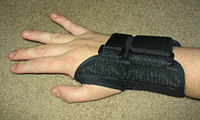
Photo from wikipedia
BackgroundFunctional disability is a significant problem after natural disasters. Musculoskeletal pain is reported to increase after disasters, which can cause functional disability among survivors. However, the effects of musculoskeletal pain… Click to show full abstract
BackgroundFunctional disability is a significant problem after natural disasters. Musculoskeletal pain is reported to increase after disasters, which can cause functional disability among survivors. However, the effects of musculoskeletal pain on functional decline after natural disasters are unclear. The present study aimed to examine the association between musculoskeletal pain and new-onset poor physical function among elderly survivors after the Great East Japan Earthquake.MethodsA longitudinal study was conducted on survivors aged ≥65 years at three and 4 years after the Great East Japan Earthquake. A total of 747 persons were included in this study. Physical function was assessed using the Kihon Checklist. New-onset poor physical function was defined as low physical function not present at 3 years but present at 4 years after the disaster. Knee, hand or foot, low back, shoulder, and neck pain was assessed using a self-reported questionnaire and was defined as musculoskeletal pain. Musculoskeletal pain at 3 years after the disaster was categorized according to the number of pain regions (0, 1, ≥ 2). Multiple logistic regression analyses were performed to calculate the odds ratio (OR) and 95% confidence interval (95% CI) for new-onset poor physical function due to musculoskeletal pain.ResultsThe incidence of new-onset poor physical function was 14.9%. New-onset poor physical function was significantly associated with musculoskeletal pain. Compared with “0” musculoskeletal pain region, the adjusted ORs (95% CI) were 1.39 (0.75–2.58) and 2.69 (1.52–4.77) in “1” and “≥ 2” musculoskeletal pain regions, respectively (p for trend = 0.003).ConclusionsMusculoskeletal pain is associated with new-onset poor physical function among elderly survivors after the Great East Japan Earthquake. Monitoring musculoskeletal pain is important to prevent physical function decline after natural disasters.
Journal Title: BMC Geriatrics
Year Published: 2019
Link to full text (if available)
Share on Social Media: Sign Up to like & get
recommendations!